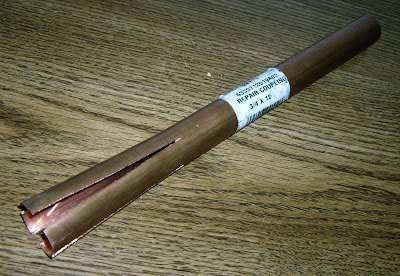Headset Removal and Replacement
 Fri, June 8, 2007
Fri, June 8, 2007 
My recent new bike build up called for the removal and replacement of the headset cups and bearings. I did this with a few simple items I picked up at my local hardware store.
To remove the bearing cups from the frame I purchased a piece of copper tube. I found a ¾ inch repair coupling that was ¾ inch diameter inside and slightly under and inch outside. These come in various lengths; 12 inch long worked fine for my needs and the ends were already machined nice and square.
All I had to do was cut four slots down the length of the tube about 4 inches long, using a hacksaw, and bend the four pieces outwards as shown in the picture above. These squeeze in to insert through the headset cup and then spring out again inside the head tube. With a hammer or mallet, the cups can be safely knocked out of the frame.
This worked in exactly the same way as the professional Campagnolo tool that costs a great deal more. To remove the lower ring from the fork, I turned the fork upside down resting the threaded end on a wooden block, and drove the ring off with a hammer and flat punch.
It is necessary to tap first one side of the ring, then the other to get it to come off straight. The bottom ring was hardened steel so the flat punch did not damage it in any way.
To press the cups in the new frame I bought a 5/8 dia. nut, bolt, and several large flat washers. I pressed the top cup in first, which again was hardened steel, with the bolt facing up and the nut on top. Tightening the nut on the bolt squeezed the cup into the frame.
Then I removed the nut and bolt, reversed it and pressed the lower cup in. (See picture, left.) The bottom cup was light alloy so I placed the lower steel fork ring inside, upside down. This brought it flush with the outside edges of the cup so the washers were pressing on the inner hardened steel bearing surfaces, rather than the soft alloy outer edge of the cup.
Don’t press the cups in with the ball bearings in place, or you may damage the balls or the bearing surfaces.
Finally, to drive the lower ring on to the fork; I found a short piece of one inch black iron pipe. This was slightly bigger than an inch inside so it slid easily over the steering column.
Holding the fork in one hand, I drove the bearing ring onto the crown race, using the piece of iron pipe as a hammer. (See picture, right.) Once again, because the lower ring is hardened steel the iron pipe did no damage. The piece of iron pipe does not have to be threaded as shown here. It just happened to come that way, in the length and weight I needed to do the job.
If you have a 1 1/8 dia. threadless steerer you will need a pipe with a larger inside diameter. Just make sure it is loose and slides easily on the steering column.
Finally, use plenty of grease in the inside of the head tube. It will help the cups slide in and prevent corrosion in the future.
 Dave Moulton | Comments Off |
Dave Moulton | Comments Off |  Bike Tech
Bike Tech 

















Reader Comments (9)
I actually used a pair of crappy old steel mtb handle bars I had laying around rather than a copper pipe.
My first attempt was a bit of failure because I didn't cut the slits particularly square - and too shallow it would seem. I managed to mangle the first half of the old bars and went back and tried a bit more thoroughly with what was left of the other half; So my tips in addition - Cut deep & straight. don't be afraid to splay the four new prongs out wide but ensure they're pretty even. Insert the uncut end through the underside of the cup you're removing and push your wieght on the frame against the bench top to help the sprung prongs wedge through 98% of the way through the cup. A little tug from the pipe extruding at the top should pop it through and have the prongs evenly resting on the inside lip of the cup inside the tube.. which is of course what you want to then bash :)
You need 22mm copper pipe, this can be bought from B&Q, however give your local plumbers merchant a call it's a hell of a lot cheaper!
Out of pocket costs - $9.44 USD. Whole removal took 30 minutes.
Why not visit www.smbbearings.com/BB_BRGS.htm for a really great article about replacing your bike's bottom bracket bearings, the photos are a real help too.
To help you get a better understanding of bearings & their performance, check out www.smbbearings.com/SMBtechdata.htm for loads of technical information & help on bearings.
HI there,
With the given tool I guess we can remove and replace easily
Thanks,
Maria